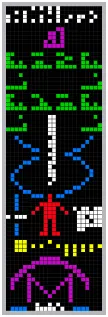If we on planet Earth do one day make contact with an intelligent, extraterrestrial or alien species, how could we hope to communicate with them?
Well, where there is life, there is language.
If you were to listen to Earth from the skies, you might hear one of 7,000 languages, and you would be forgiven for thinking only humans had evolved language.
But you would be wrong.
More on alien life

Chimpanzees gesture instructions and emotions, whales sing to each other.
Prairie dogs have vocal warnings so complex that experts believe they can describe the size, shape and colour of the threat to their clan.
Life’s capacity for language astounds me, and it gives me hope.
Hope that life orbiting around distant stars may also have the capacity for language and communication.

So the question is not, "Do intelligent aliens exist?" but, "Could we communicate with them?"
Arecibo message
In 1974, my friend the late Frank Drake (creator of the Drake Equation) sent a message to a distant cluster of stars from the largest radio telescope in the world.
It's known today as the Arecibo message – the first radio message to aliens.
At the time, what Frank sent was the result of a phenomenal effort to create a succinct interstellar postcard and then communicate it in the best way he could think of.
Through the universal language of maths and science.

He used binary code across two different radio frequencies to communicate how we count, the structure of the DNA molecule, what humans look like, and much more.
I was a teenager back then and was inspired by Frank’s ingenuity.
When I grew up, I eventually joined Frank’s team at SETI – the Search for Extraterrestrial Intelligence.
Over the years I started to think of ways we could create and transmit a much wider range of new messages that could stand a better chance of being understood by intelligent lifeforms.
And so, in 2015 I created METI International to do just that.

Understanding METI
METI stands for Messaging Extraterrestrial Intelligence, and its messages are treasure troves of science, art, and human nature, with many different ways to unlock their secrets.
As we send the periodic table of elements, we talk about the chemical building blocks of the Universe – something scientists on another planet will also understand.
We use maths to describe beautiful shapes that are built into nature, like the spiral of the nautilus shell.

And we create interstellar morality plays that start telling aliens what it’s like to be human.
We’ve designed our messages so that any alien species that is capable of receiving radio signals could decipher and understand them.
There is one more critical difference between METI’s messages and Frank’s: the stars we target.

Sending messages into space
In 1974, Frank sent his message to a distant cluster of stars in Hercules, known as M13, or the Hercules globular cluster.
This globular cluster is so far away that if SETI were to receive a response to the message, it would take 50,000 years to arrive.
Who even knows if we’ll still be here to accept it? If we really want to try and communicate with aliens we can do better than that and so, in contrast, METI sends its messages to stars much closer to home.
If our messages are received, deciphered and replied to, we could receive a response in as little as a decade (if we are lucky).
If extraterrestrials do get our messages, will they understand them?
And what will they say back?
Will they use the language of binary numbers?
Will they show us what they look like?
Will they tell us what they find beautiful?
Will they say hello?
To me, this is the real mystery.
What message will they transmit back from their distant star? With METI, and a bit of patience, we now have a way to find out.
This article originally appeared in the February issue of BBC Sky at Night Magazine.

